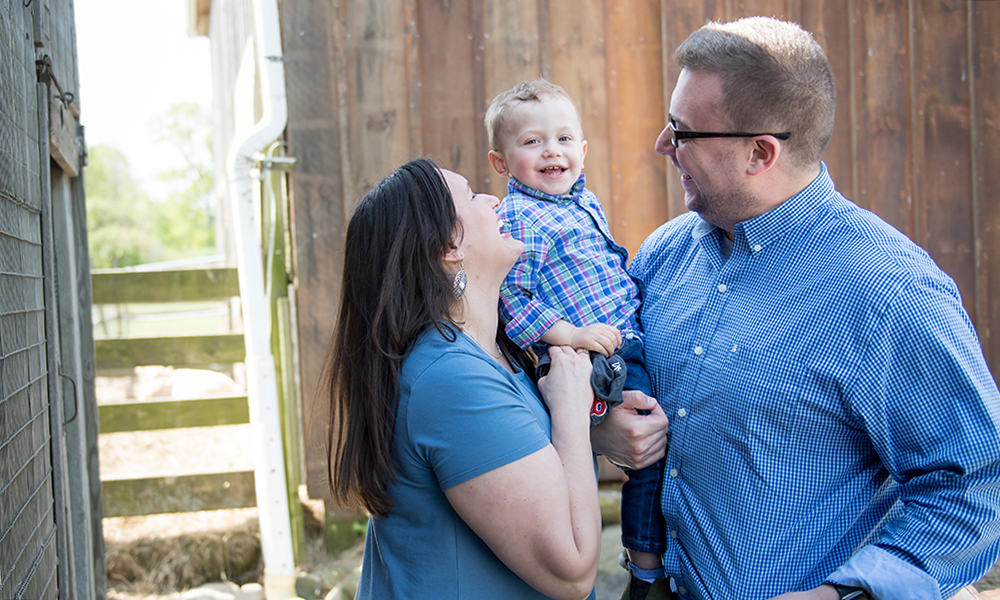Patient StoryAug | 8 | 2019
Grayson’s story: Hurdle by hurdle, toddler reaches the finish line with family-centered care


In 2017, Ashley McAlpine and her husband, Garret, went to her 20-week ultrasound. It was supposed to be an exciting appointment to find out their baby’s sex, but it quickly plunged into uncertain territory.
Doctors diagnosed the McAlpine’s baby boy with a congenital diaphragmatic hernia (CDH), a hole in the diaphragm muscle that fails to close during pregnancy. Other organs, such as the liver, stomach or intestines, can travel through the hole into the chest. When abdominal (belly area) organs migrate into the chest, this prevents the lungs from developing properly and reduces blood flow to the lungs. Like many babies with CDH, baby Grayson had a 75 percent chance of survival after birth.

The McAlpines were transferred from their local hospital in Maine to the Fetal Care Program at MassGeneral for Children (MGfC). After a nerve-racking three-hour drive from their home in Brunswick, Maine, the McAlpines were greeted with something they had not experienced up to that point – hope.
“We first met Dr. Kelleher in the Fetal Care Program. She was the first person to speak about our son as a person and not an unknown, hopeless case. She actually congratulated us on our baby,” said Garret. “Before that, it was an emotional freefall and no one provided any sense of hope.”
To the McAlpines, the hospital’s concrete main entrance felt like a red carpet. When families arrive to the Fetal Care Program, Karen Parsons, RN, nurse coordinator, helps to schedule as many appointments on the same day as possible and escorts them to each one.
“It was like watching a well-oiled machine. We were updated constantly and never felt like we were in the dark. Their attention to detail is amazing and they stayed the course the whole way through,” said Garret. “You would think it’s VIP treatment, but really, it’s what they do for everyone.”
After meeting Kelleher, the remainder of Ashley’s pregnancy and the beginning of Grayson’s life were measured in hurdles. The first was making sure Ashley reached a full-term pregnancy, and then came planning for a safe birth. The next hurdle was stabilizing Grayson for surgery.
At MGfC, care plans and appointments are customized to the unique needs of every patient and family. “We are very patient and family-centered. We don’t have a prescribed care plan that applies to all patients because they all have different needs and expectations,” said Cassandra Kelleher, MD, surgical director of the Fetal Care Program and the Neonatal Intensive Care Unit (NICU) at MGfC. “Congenital issues are only a small part of our patients.”
At the end of July 2017, Ashley and Garret made the three-hour drive to Boston once more in preparation for Grayson’s arrival. On August 4, 2017, Grayson was born and immediately intubated and transported to the NICU. Three days later, he underwent surgery to repair the CDH.
Initially, Grayson came through surgery with no complications or concerns. Then, Ashley and Garret noticed he had turned gray. He had developed pulmonary hypertension (high blood pressure in the lungs) and his heart was working overtime to compensate. To let his tiny heart and lungs rest, Grayson was placed on extracorporeal membrane oxygenation (ECMO), a type of life support that temporarily replaces the function of the heart and lungs.
“I remember Grayson doing so well initially and then suddenly, we were having a conversation about putting him on ECMO,” said Kelleher. “The dichotomy of those two conversations is so powerful. I remember giving Ashley and Garret a hug because it was such a heart-wrenching conversation.”
Grayson remained on ECMO for 13 days, during which he encountered yet another hurdle. He developed chylothorax, a condition in which lymph fluid formed in his digestive tract and collected in his chest, a result of having trouble digesting fat in Ashley’s breast milk. This required placing a chest tube and medication. Due to ongoing challenges with oral feeding, the care team also placed a gastrointestinal feeding tube to help Grayson eat on November 9, 2019. Four days later, Grayson finally went home to Maine.
Now, almost at age 2, Grayson is a shining example of what it means to reach the finish line no matter what obstacles are in place. He is a happy toddler with endless curiosity about the world around him. He has been discharged from physical therapy, occupational therapy and feeding specialists. This summer, he will start daycare and had his feeding tube removed.
“Since coming home, he has thrived,” said Ashley. “We are so grateful to see him living a normal, happy life like any other kid.”
Related Pages
Type
Centers and Departments
Topics
Appointments and Referrals
Request an appointment or second opinion, refer a patient, find a doctor or view test results with MGfC's secure online services.


